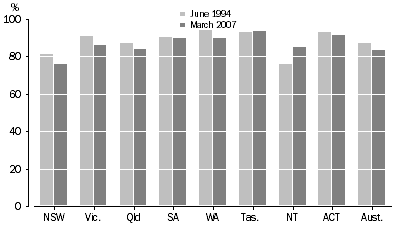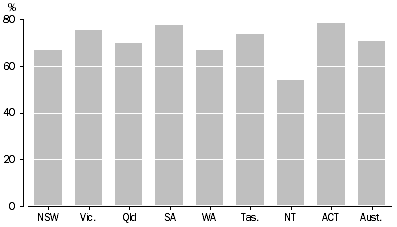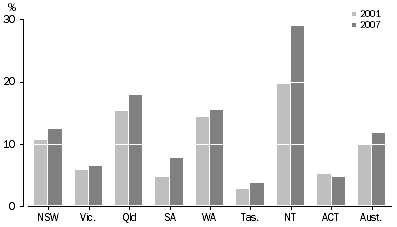INTRODUCTION
This chapter focuses on water use and conservation in the garden and outside the home. It contains data on the methods used for watering gardens and steps taken to save water in the garden and other outside areas. It also presents data on households with swimming pools and some characteristics of those pools.
Households with gardens
In March 2007 more than four out of five Australian households had their own garden at their dwelling (83.5% or 6,733,600) (table 5.4 and graph 5.1). Tasmanian households were most likely to have their own garden (93.6%). Since 1994, the proportion of households without their own garden had risen from 12.6% to 16.5% in 2007. In New South Wales, 23.9% households did not have their own garden, the highest of any state or territory and an increase from 18.6% in 1994.
5.1 Households with gardens, 1994 and 2007

Methods used in watering
The most common methods reported by Australian households for watering the garden were hand watering with a bucket or watering can (31.8%) and hand watering with a normal hose (23.2%) (table 5.5). Slightly more than one-quarter (25.5%) of households with a garden do not water or rely on rainfall only.
Households in capital cities were more likely than those in other parts of the states to hand water with a bucket or watering can, 35.0% to 26.5% respectively. In Victoria, 48.5% of households hand watered with a bucket or watering can.
Victoria had the lowest proportion of households watering with a normal hose (9.1%) and Western Australia the highest (39.8%).
Forty per cent of Queensland households do not water or rely on rainfall only. In Brisbane, 47.9% of households do not water or rely on rainfall only compared to 33.3% in the rest of Queensland.
Group households were the most likely households to not water or to rely on rainfall only (46.4%) (table 5.6). This compared to 24.7% for family households and 25.9% for lone person households.
Steps taken to save water in the garden
For all of Australia, 70.9% of households reported taking steps to save water in the garden. Households in the Australian Capital Territory, South Australia and Victoria were most likely to have reported taking steps to save water in the garden (78.2%, 77.8% and 75.5% respectively) (table 5.7). Western Australian and New South Wales households (both 66.8%) and Northern Territorian households (54.0%) were the least likely to have reported taking steps to save water in the garden.
Households renting their dwelling were less likely to have taken steps to save water in the garden (58.2%) than households that were owner occupiers (74.5%) or purchasers of their dwelling (74.7%) (table 5.9).
Almost three-quarters of family households (72.3%) and 68.1% of lone person households reported taking steps to save water in the garden. Only 55.1% of group households took steps to save water in the garden.
Of households that paid all of their water costs, 73.5% reported saving water in the garden whereas only 59.4% of households saved water in the garden where the landlord or someone else paid for the water costs.
Thirty per cent of Australian households saved water in the garden by using grey water. Victoria had the greatest proportion of households using greywater (46.2%), followed by the Australian Capital Territory (36.2%) and Queensland (27.6%) (table 5.8).
Using mulch was the second most reported method used by Australian households to save water in the garden. Tasmanian households had the greatest reported use of mulch in the garden (39.9%), followed by Western Australia (31.4%).
Watering only when necessary was the third most common way to save water in the garden, with 20.4% of Australian households reporting this water saving activity. In South Australia, 25.6% of households watered only when necessary, which is the highest of all states and territories. Tasmania was second highest with 25.3% of households.
5.2 Households that save water in the garden, 2007

Steps taken to save water outside
Almost two-thirds of households took steps to save water outside (other than in the garden). Only 32.5% of households reported no water saving activities or did not know. In the Northern Territory however, 62.2% of households reported no water saving activities outside (other than in the garden) (table 5.10).
The most common step taken was to not wash the car or wash the car less often (29.2%). Commercial car washing facilities were used by 17.8% of households. The Australian Capital Territory had the highest proportion of households reporting the use of commercial car washes (30.6%) followed Victoria (26.2%).
Swimming Pools
The proportion of households with swimming pools increased slightly to 11.7% in 2007, up from 11.3% in 2004 and 10.0% in 2001 (table 5.11). The states and territories covering Australia's north had the highest proportion of households with swimming pools: Northern Territory 28.9%, Queensland 17.9% and Western Australia 15.4%. The southern most state, Tasmania had the lowest proportion of households with swimming pools (3.8%).
5.3 Households with Swimming pool at dwelling, 2001 and 2007

In-ground pools made up the majority of Australian pools, with 9.8% of households having an in-ground pool and 2.0% of households having an above-ground swimming pool.
Of the 944,600 households with swimming pools, 46.1% were both treated and filtered, a further 43.9% were only filtered and 5.8% were treated only (table 5.11). The proportion of pools being both treated and filtered has increased by 4.2 percentage points from 41.9% in 2001.
 Print Page
Print Page
 Print All
Print All